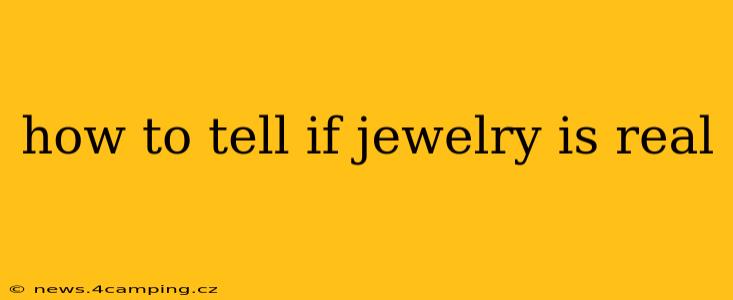Determining whether your jewelry is genuine can be tricky, especially with the prevalence of high-quality counterfeits. This guide provides a range of methods to help you authenticate your precious metals and gemstones, from simple at-home tests to professional appraisals. Knowing how to identify real jewelry protects your investment and ensures you're getting what you paid for.
What are the common tests to check if jewelry is real gold?
Several tests can help determine if your gold jewelry is genuine. However, it's crucial to understand that these are preliminary checks and not foolproof. A professional assay is necessary for definitive confirmation.
-
The Magnet Test: Gold is not magnetic. If a magnet sticks to your jewelry, it's likely not pure gold or contains significant amounts of magnetic metals. However, some gold alloys might show slight magnetic attraction, so this test isn't conclusive.
-
The Acid Test: This involves applying a small amount of acid (usually nitric acid) to a hidden area of the jewelry. The reaction of the acid with the metal indicates its purity. Pure gold will not react, while other metals will. Caution: This test should only be performed by a professional jeweler due to the corrosive nature of the acid and the potential for damage to the jewelry.
-
The Density Test: Gold is very dense. Measuring the weight and volume of the jewelry allows you to calculate its density. If the density is significantly lower than that of gold, it suggests it's not pure gold. This test requires specialized equipment and is best performed by a professional.
-
Hallmarks and Stampings: Legitimate gold jewelry often bears hallmarks or stamps indicating its karat (e.g., 18K, 24K). These markings provide information about the gold's purity. Be aware that counterfeit pieces may also display fake hallmarks.
How can I tell if my jewelry is real silver?
Similar to gold, several tests can be used to authenticate silver jewelry:
-
The Magnet Test: Like gold, pure silver is not magnetic. However, this isn't a definitive test as some silver alloys might display slight magnetic attraction.
-
The Acid Test (for silver): This method is similar to the gold acid test. Specific acid is applied to a hidden part of the jewelry, the reaction determining the silver content. Again, this requires expertise and should be handled by a professional jeweler to avoid damage.
-
The Hallmarking Method: Genuine silver pieces often feature hallmarks indicating the silver's purity (e.g., sterling silver, 925). These markings should be carefully examined.
-
The Conductivity Test: Silver is an excellent conductor of electricity. A simple conductivity tester can measure this property. Low conductivity suggests the piece may not be made of genuine silver. However, this test may not be readily available to the average person.
What are some ways to tell if gemstones are real?
Identifying real gemstones requires a combination of visual inspection, testing, and sometimes, professional evaluation.
-
Visual Inspection: Examine the clarity, color, and inclusions (internal features) of the gemstone. Real gemstones often have natural imperfections or inclusions that are unique to each stone. Perfectly flawless gemstones should raise suspicion.
-
Hardness Test: Gemstones vary in hardness. A scratch test (carefully comparing the stone against known hard materials) may provide an indication, but it can also damage the gemstone. This should be avoided unless you're knowledgeable about gemstone hardness.
-
Refractive Index Test: A refractometer measures the way light bends when it passes through a gemstone. This provides a reliable indication of the gemstone's identity. This is a more sophisticated test best performed by a gemologist.
-
Magnification: A jeweler's loupe will allow for close inspection of inclusions and other characteristics within the gemstone.
What should I do if I suspect my jewelry is fake?
If you suspect your jewelry isn't genuine, it's best to seek professional help. A reputable jeweler or gemologist can perform comprehensive tests to determine the authenticity of your pieces. They possess the necessary knowledge, tools, and experience to provide an accurate assessment.
How can I protect myself from buying fake jewelry?
- Buy from reputable dealers: Purchasing from established jewelers or known online retailers reduces the risk of encountering counterfeit items.
- Check for certifications: Genuine gemstones often come with certificates of authenticity from reputable gemological laboratories (e.g., GIA, AGS).
- Inspect the jewelry carefully: Before purchasing, thoroughly examine the piece for hallmarks, clarity, and any inconsistencies.
- Be wary of suspiciously low prices: If a deal seems too good to be true, it probably is.
By following these guidelines and employing a combination of techniques, you can significantly improve your ability to determine whether your jewelry is genuine. Remember, professional appraisal remains the most reliable way to confirm the authenticity of precious jewelry and gemstones.
